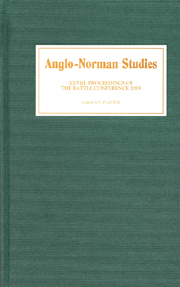Book contents
- Frontmatter
- Contents
- LIST OF ILLUSTRATIONS, MAPS, AND TABLES
- EDITOR'S PREFACE
- ABBREVIATIONS
- Inside the Anglo-Norman Family: Love, Marriage, and the Family (R. Allen Brown Memorial Lecture)
- Land Tenure and Royal Patronage in the Early English Kingdom: A Model and a Case Study
- The Homilies of a Pragmatic Archbishop's Handbook in Context: Cotton Tiberius A. iii
- Robert de Vaux and Roger de Stuteville, Sheriffs of Cumberland and Northumberland, 1170–1185
- The Common Steeple? Church, Liturgy, and Settlement in Early Medieval Lincolnshire
- The Question of Masculinity in William of Malmesbury's Presentation of Wulfstan of Worcester
- Share and Share Alike? Bishops and their Cathedral Chapters: The Domesday Evidence
- Dunstan and Monastic Reform: Tenth-Century Fact or Twelfth-Century Fiction?
- Domesday Now
The Homilies of a Pragmatic Archbishop's Handbook in Context: Cotton Tiberius A. iii
Published online by Cambridge University Press: 12 September 2012
- Frontmatter
- Contents
- LIST OF ILLUSTRATIONS, MAPS, AND TABLES
- EDITOR'S PREFACE
- ABBREVIATIONS
- Inside the Anglo-Norman Family: Love, Marriage, and the Family (R. Allen Brown Memorial Lecture)
- Land Tenure and Royal Patronage in the Early English Kingdom: A Model and a Case Study
- The Homilies of a Pragmatic Archbishop's Handbook in Context: Cotton Tiberius A. iii
- Robert de Vaux and Roger de Stuteville, Sheriffs of Cumberland and Northumberland, 1170–1185
- The Common Steeple? Church, Liturgy, and Settlement in Early Medieval Lincolnshire
- The Question of Masculinity in William of Malmesbury's Presentation of Wulfstan of Worcester
- Share and Share Alike? Bishops and their Cathedral Chapters: The Domesday Evidence
- Dunstan and Monastic Reform: Tenth-Century Fact or Twelfth-Century Fiction?
- Domesday Now
Summary
British Library, Cotton MS Tiberius A. iii, a bilingual compilation manuscript of some ninety-four texts and two full-page illustrations, was produced at Christ Church, Canterbury, sometime between 1012 and 1023. To modern sensibilities the manuscript presents an incongruous assortment of texts: monastic rules, homilies, liturgy, confessional directives, prognostics, scientific treatises, extra-canonical notes and commonplaces, hagiography, a charm, a lapidary, a manual for monastic sign language, and the examinatio of an incumbent bishop (Appendix, Table 2, lists the contents of the manuscript). By examining concurrent text and quire endings and the distribution of the manuscript's scribal hands it has been possible to conclude that the manuscript was produced in one scriptorium at one time, and this farrago was, therefore, intended. The 194 folios of vellum and five scribes involved in the production of Cotton Tiberius A. iii, hereafter referred to as T, represent a considerable investment of resources, which in turn implies that the manuscript was produced with a specific and important function in mind.
More than half of the texts in T are pertinent to pastoral care, but it is clear that texts such as the examinatio of the bishop and the opening monastic texts would be largely irrelevant to such usage. Helmut Gneuss undertook a study of the origin and provenance of the manuscript, and commented that the examinatio of the bishop might ‘give us a hint as to who would have consulted this book’, and this did actually prove to be the key to my understanding of T. Only an archbishop could examine an incumbent bishop; and an archbishop of Canterbury, in the fulfilment of his diverse roles, would find not only this text but all the other texts in T useful as well. T, then, or so it seems to me, is an archbishop’s commonplace book or pragmatic handbook
- Type
- Chapter
- Information
- Anglo-Norman Studies 28Proceedings of the Battle Conference 2005, pp. 47 - 64Publisher: Boydell & BrewerPrint publication year: 2006

